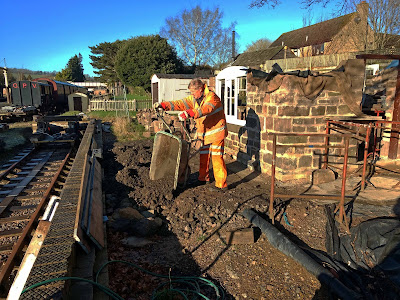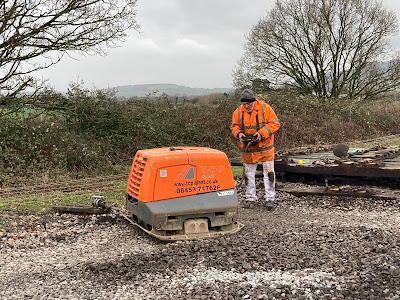Tuesday on the canopy.
This was supposed to be the day of the big lift, but we were a day ahead, so on Tuesday we spent the day mounting a fascia board and drilling, drilling.
The first thing we did was to cut the purlins to the correct length. As there were several of them, we used quite a few cutting discs.
Next, our attention turned to the car park side fascia board. This is lying sideways on the scaffolding, the wrong length, and not quite in the right place.
It is due to go into this piece of brickwork that we have opened out.
The fascia board is of course also at the wrong level, so how to get bit higher, without a crane?
The answer was to jack it up, bit by bit, with the pallet truck, inserting little pallets as we went up.
The Malvern side fascia board was put up on Monday, but in this picture only has two securing bolts in it - more drilling needed here.
After some pumping of the pallet truck, and a heave-ho from the 4 volunteers on site today, the car park side fascia board was clamped into position. The cut out can be seen on the end.
Then it was time to secure that one too with bolts, for which holes had to be drilled through several layers of steel. It's done with a magnetic drill, a marvellous invention that clings to the surface and allows you to exert quite some force onto the drill bit.
 |
| The first securing bolt goes in. A triumph! |
After a heavy duty drilling session, each hole through three layers of steel, we had eight bolts in on the southern half of the fascia board. That ought to hold it.
Today we had the honour of a visit from P&O stalwart Steve, and we split into two teams, thanks to Steve. Neal was on the southern end of the fascia bard, and Steve and yours truly on the northern end. Drilling.
At the end of the day we had 8 bolts through on each end of the fascia board - 16 holes drilled and bolted up, out of about 80 that we have to do.
At the time of writing we are still planning to do riveting on Friday. The weather looks good for that.
More drilling took place all day on Wednesday.
Wednesday with the Usketeers.
Too cold again to lay blocks - it was minus two degrees on arrival this morning.
Everything as covered in ice and hoar frost, with some additional fog locally to brighten up the journey. We arrived with the car headlights on, and left with the car headlights on. It's still dark and the days are short.
Electricians came today to do a rewire at Winchcombe, another one of those necessary costs for which you don't see the result. Except that the light stays on when you switch on another kettle.
In the upper yard we had new road markings being painted. They are slightly different from the old ones - it now says 'Private - No parking' outside Churchward House, and all the other separation stripes have been renewed, including outside Halls, which have a big 'Keep Clear'. We do wonder how Halls get their big articulated lorry in and out of the double bend at the top of the yard, where the residents ignore the double yellow lines and park awkwardly on our station approach.
There was a thin film of frost on the top layer of stones of the hut, and his confirmed that we should desist from mixing any mortar.
The first thing we did then was to have a cup of coffee in our 'welfare facility' (tin hut), accompanied by a bun from John. We thought we'd let the temperature rise a bit in the sun, which wasn't forecast on the BBC site we consulted. But it was there alright.
To keep us warm, all three of us decided to shovel spent ballast. With three of us on the go, the wheelbarrow sure filled up quick, and we took it in turns to take it down to behind the platform.
We did 7 or 8 loads, and that pretty much filled the former hollow area filled with broken bricks. We now have a nice level platform on which to place our trestles on this face.
After the digging we were indeed much warmer, and the sun shone so brightly that we took our coats off. We began to wonder if we weren't being a bit conservative with the frost and the mortar. Maybe we could lay a few blocks in the afternoon?
As an interlude, Dave went down to the new standpipe by the mess coach (currently at Toddington) to complete the lagging that was started last week. It's now properly protected against frost, and has half a bucket upside down on top to keep out the rain. That should do it.
Yours truly walked up to the slip site in the cutting, to ask nicely about taking a picture, and find out how they were doing.
The answer is that they are about a week ahead of schedule, which is good news. The sheet piling is all in, an so are the soil nails. But where were they - we couldn't see any of the exposed tops on the slope.
The answer was that the soil nails were driven under the gardens of the new houses, through holes in the top of the piles. Those piles were now being linked by a row of girders, just like at the slip at Manor Lane.
After that the slope will be re-graded, so allowing the 'Lego' blocks to be moved back about two metres. Lastly, a series of counterfort drains will be created. These run at right angles to the track, from the top to the bottom of the slope.
Meanwhile, back at the farm...
Dave had thrown together a first mix from Maxie, and was just collecting it in the barrow.
We assembled a trestle on the corner nearest the station and started work on bedding down the stones placed there loosely last week.
Here you can see the heavy corner quoin on its side, with Dave making a mortar bed for it to be rolled on. It then gets taps from a lump hammer this way and that, until it is vertical and in the correct position. All checked with a builder's level.
With the quoin down, Dave moved right a bit, and laid a row of 4 inch blocks to the window. The loose block up against it was also bedded down, so that we now have the top block on each side of the window.
We then moved left, and laid a block against the window at the front, and one to join it to the quoin on the corner.
This was followed by raising the interior up against this area, aka backing up. It should enable us to lay another row here next time, winter weather permitting.
As we were doing this, John got our roll of Hessian out, and cut off enough to lay over today's corner work, nice and thick to keep it snug for the night. That is expected to be cold, albeit without frost (or not much of it anyway).
This is a last shot of the same corner, showing the backing up Dave did on the inside. As you can see the block against the big arched window is in, but needs a second one behind it. We can only do that when the backing up underneath has gone off, otherwise everything will slip out of place. We want to get the supports for the brick arch into place - it will rest on the big quoins up against the top corner.
Dave observed that mortar laid some weeks ago was now quite hard. Good news, for us amateurs.
A few shots of the PWay gang at CRC
Work continues on a pretty much complete replacement of the steel parts of the northern loop turnout here.
Walt took these pictures on Tuesday:
The widest section of the turnout was dug out before Christmas, and then back filled with recovered or clean ballast.
On Tuesday a robot compactor (or Whacker) was used on the site. We have never done this before, and hopefully this will prevent the turnout from moving once those heavy locos run over it again in March.
Here's the job after the robot has passed - nice and level, and of course compacted.
Today, Wednesday, the gang was at CRC again, and we thank Bob for the next two snapshots of the work there.
In this picture the timbers have been laid out again. There is still some life in them (and the cost of new is appalling) so pegs are being hammered into the old screw holes. The new pointwork has a tighter curvature than the last one (which was cracked and had to go) so the screws will be inserted in different locations, and everything needs re-drilling.
The pegs are hammered in until they won't go any further, then the rest is cut off with a saw.
Now they are ready to place some of the rails on top.
That's what you can see in this picture.
The new crossing has been laid in, and base plates are being laid out for the next set of rails.
A hired in digger does the heavy lifting.
The gang will return here on Saturday, while another gang will make a start at Toddington, where there is a short job at Toddington South. You may remember that we plain lined a new turnout there due to a mix up over the thickness of certain base plates. These will now be corrected, and the new turnout returned to service. That then releases the locos from the yard, given that the crossover is being replaced.
Contractors have delivered fresh ballast to Toddington car park, and work on replacing the crossover by the goods shed is about to start. This is being done by contractors - we can't do everything at once!




























Have Steve and his JCB now been retired, as he was a permanent part of the PW activity upto Covid?
ReplyDeleteSadly, Steve is not well, and much to our regret it doesn't look like he will work for us now (Steve was a contractor). We really miss him!
DeleteSuperb work chaps ! Makes me quite ashamed when I shiver just putting out the rubbish bag.
ReplyDeleteI believe that an ex American president said that, "A man who cuts his own fuel warms himself twice". Seems to fit with the barrowing of spent ballast.
Regards, Paul.
Perhaps, when in their final location, the lego blocks could be disguised by facing with blue bricks or stone.
ReplyDeleteOr some old wooden sleepers
DeleteI like the idea of facing the blocks with sleepers. Maybe not even complete sleepers - if I remember correctly, the concrete block platform at Hayles Abbey Halt was disguised by thin planks which outwardly look like full-thickness sleepers.
DeleteA cheap and easy way of hiding the blocks would simply be to plant a few sprigs of ivy along the bottom. It will soon climb up the blocks. It might need a trim once in a while, but the lineside vegetation is trimmed from time to time anyway, so it wouldn't create any extra work.
A fine blog...so sorry to hear about Steve..he was an enormous help.
ReplyDeleteJust looking at the line of the canopy, will an extra down pipe be fitted for water from the extension, as it seems to require one when looking at the dagger board line?
ReplyDeleteRergards, Paul.
There will be downpipes down the uprights. We've got all the kit.The underground drains were installed at an early stage!
Delete